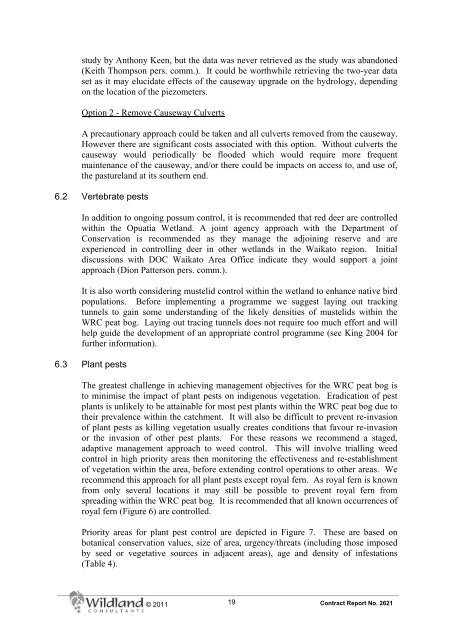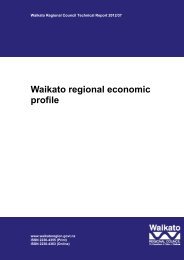Opuatia Peat Bog Management Plan - Waikato Regional Council
Opuatia Peat Bog Management Plan - Waikato Regional Council
Opuatia Peat Bog Management Plan - Waikato Regional Council
Create successful ePaper yourself
Turn your PDF publications into a flip-book with our unique Google optimized e-Paper software.
study by Anthony Keen, but the data was never retrieved as the study was abandoned<br />
(Keith Thompson pers. comm.). It could be worthwhile retrieving the two-year data<br />
set as it may elucidate effects of the causeway upgrade on the hydrology, depending<br />
on the location of the piezometers.<br />
Option 2 - Remove Causeway Culverts<br />
A precautionary approach could be taken and all culverts removed from the causeway.<br />
However there are significant costs associated with this option. Without culverts the<br />
causeway would periodically be flooded which would require more frequent<br />
maintenance of the causeway, and/or there could be impacts on access to, and use of,<br />
the pastureland at its southern end.<br />
6.2 Vertebrate pests<br />
In addition to ongoing possum control, it is recommended that red deer are controlled<br />
within the <strong>Opuatia</strong> Wetland. A joint agency approach with the Department of<br />
Conservation is recommended as they manage the adjoining reserve and are<br />
experienced in controlling deer in other wetlands in the <strong>Waikato</strong> region. Initial<br />
discussions with DOC <strong>Waikato</strong> Area Office indicate they would support a joint<br />
approach (Dion Patterson pers. comm.).<br />
It is also worth considering mustelid control within the wetland to enhance native bird<br />
populations. Before implementing a programme we suggest laying out tracking<br />
tunnels to gain some understanding of the likely densities of mustelids within the<br />
WRC peat bog. Laying out tracing tunnels does not require too much effort and will<br />
help guide the development of an appropriate control programme (see King 2004 for<br />
further information).<br />
6.3 <strong>Plan</strong>t pests<br />
The greatest challenge in achieving management objectives for the WRC peat bog is<br />
to minimise the impact of plant pests on indigenous vegetation. Eradication of pest<br />
plants is unlikely to be attainable for most pest plants within the WRC peat bog due to<br />
their prevalence within the catchment. It will also be difficult to prevent re-invasion<br />
of plant pests as killing vegetation usually creates conditions that favour re-invasion<br />
or the invasion of other pest plants. For these reasons we recommend a staged,<br />
adaptive management approach to weed control. This will involve trialling weed<br />
control in high priority areas then monitoring the effectiveness and re-establishment<br />
of vegetation within the area, before extending control operations to other areas. We<br />
recommend this approach for all plant pests except royal fern. As royal fern is known<br />
from only several locations it may still be possible to prevent royal fern from<br />
spreading within the WRC peat bog. It is recommended that all known occurrences of<br />
royal fern (Figure 6) are controlled.<br />
Priority areas for plant pest control are depicted in Figure 7. These are based on<br />
botanical conservation values, size of area, urgency/threats (including those imposed<br />
by seed or vegetative sources in adjacent areas), age and density of infestations<br />
(Table 4).<br />
© 2011<br />
19<br />
Contract Report No. 2621

















